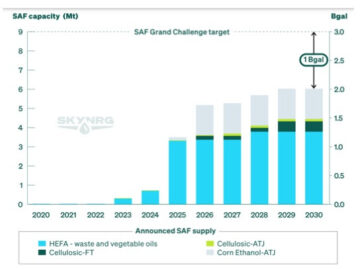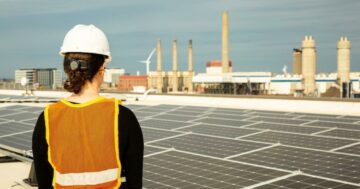
This week Microsoft released its fourth Carbon Removal report analyzing its carbon removal buying. Every year, Microsoft, a leader in investing in carbon removal technologies, writes about updates to its carbon removal efforts and the volumes of tons it has contracted to be removed.
Its annual report is notable for its transparency and because it indicates where money is flowing in the carbon removal market. The company also explains a few trends it notices during the due diligence process on its carbon removal projects as well as startups it is contracting with.
While many companies focus on getting to carbon neutral for current emissions, Microsoft has planned, by 2030, to offset its entire historical emissions going back to when the company was founded in 1975.
Indeed its making progress: In 2022, Microsoft’s portfolio had 1.5 million metric tons of contracted carbon removal. This year with a big purchase from energy provider Ørsted, which will capture and store carbon from biomass, Microsoft’s contracted carbon removal rose to almost 5 million metric tons. Many of these agreements are for multiple years.
While its contracted volumes grew, this year’s report was otherwise largely similar to last year’s — suggesting not much else has changed. Here are three new developments that stood out:
1. Microsoft added ocean carbon removal to its portfolio
Microsoft, like many other corporations, has become interested in carbon removals from the ocean. It contracted 12,000 metric tons of CO2 removed by Main-based Running Tide’s seaweed sinking process under the company’s high durability tranche of removals.
The technologies it uses include seaweed sinking, microalgae cultivation to pull carbon out of the atmosphere and into the ocean, and electrochemistry using ocean water that draws out CO2 to be sequestered.
But with all this activity, Microsoft says there is a dearth of strong certifications and policies around the measurement, reporting and verification (MRV) for these new tools to track their effectiveness. Startups and corporations in this space will need to innovate new techniques and tools for reporting and also work with governments to create standards and permits for doing this new type of commercial activity in international waters.
2. Carbon removal will happen where infrastructure can be built
Carbon removal will require a lot of capital investment and construction of new facilities–giant carbon sucking machines, thousands of miles of pipeline laid to transport the CO2, and many wells dug to inject the CO2 into the ground for storage.
But with all this activity, Microsoft says there is a dearth of strong certifications and policies around the measurement, reporting and verification (MRV) for these new tools to track their effectiveness.
Microsoft’s report pointed out that the locations most amenable to construction projects will be the fastest to uptake carbon removal projects and reap the benefits. Microsoft noted is has investment from companies such as Climate Robotics, Carbon Capture and Land O’ Lakes’ in Texas, Arkansas, Wyoming and the Great Plains.
3. There’s momentum around CO2 storage projects
Pulling carbon out of air is only half the battle — it has to go somewhere for long term sequestration. Microsoft says carbon storage hubs have started popping up in places such as the Gulf Coast near subterranean geological formations that are perfect for storing carbon dioxide underground. It also highlights startup collaborations between Heirloom, which does direct air capture, and CarbonCure, which stores carbon in concrete.
But Microsoft calls for storage providers to understand the important risk of reversal for stored carbon, the need for widely-accepted standards for both storage and transport, as well as government policy.
- SEO Powered Content & PR Distribution. Get Amplified Today.
- PlatoData.Network Vertical Generative Ai. Empower Yourself. Access Here.
- PlatoAiStream. Web3 Intelligence. Knowledge Amplified. Access Here.
- PlatoESG. Automotive / EVs, Carbon, CleanTech, Energy, Environment, Solar, Waste Management. Access Here.
- BlockOffsets. Modernizing Environmental Offset Ownership. Access Here.
- Source: https://www.greenbiz.com/article/microsoft-report-3-emerging-carbon-removal-trends-2023
- :has
- :is
- :not
- :where
- $UP
- 000
- 1
- 12
- 2022
- 2023
- 2030
- 9
- a
- About
- activity
- added
- agreements
- AIR
- All
- also
- analyzing
- and
- annual
- ARE
- arkansas
- around
- AS
- Atmosphere
- back
- Battle
- BE
- because
- become
- benefits
- between
- biomass
- both
- Buying
- by
- Calls
- CAN
- capital
- capture
- carbon
- carbon capture
- carbon dioxide
- certifications
- changed
- Climate
- Cms
- co2
- Coast
- commercial
- Companies
- company
- Company’s
- construction
- contracting
- Corporations
- create
- cultivation
- Current
- developments
- diligence
- direct
- does
- doing
- draws
- due
- durability
- during
- effectiveness
- efforts
- else
- emerging
- Emissions
- energy
- Entire
- Every
- Explains
- fastest
- few
- Flowing
- Focus
- For
- Founded
- Fourth
- from
- getting
- Go
- going
- Government
- Government policy
- Governments
- great
- Ground
- had
- Half
- happen
- Have
- here
- High
- highlights
- historical
- HTTPS
- important
- in
- include
- indicates
- Infrastructure
- inject
- innovate
- interested
- International
- into
- investing
- investment
- IT
- ITS
- jpg
- Land
- largely
- Last
- leader
- like
- locations
- Long
- Lot
- Machines
- Making
- many
- Market
- measurement
- metric
- Microsoft
- million
- Momentum
- money
- most
- much
- multiple
- Near
- Need
- Neutral
- New
- notable
- noted
- ocean
- of
- offset
- on
- only
- Other
- otherwise
- out
- perfect
- pipeline
- Places
- plato
- Plato Data Intelligence
- PlatoData
- policies
- policy
- portfolio
- process
- Progress
- projects
- provider
- providers
- purchase
- released
- removal
- Removed
- report
- Reporting
- require
- Reversal
- Risk
- robotics
- ROSE
- rt
- running
- s
- says
- sequestration
- similar
- somewhere
- Space
- standards
- started
- startup
- Startups
- storage
- store
- stored
- stores
- strong
- such
- techniques
- Technologies
- term
- texas
- that
- The
- their
- There.
- These
- this
- this year
- thousands
- three
- to
- tons
- tools
- track
- Transparency
- transport
- Trends
- type
- under
- understand
- Updates
- uses
- using
- Verification
- volumes
- was
- Water
- Waters
- week
- WELL
- Wells
- when
- which
- will
- with
- Work
- Wyoming
- year
- years
- zephyrnet










